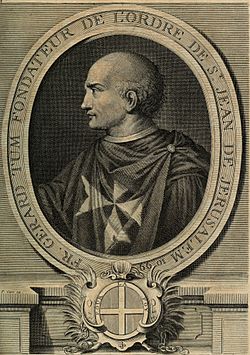Blessed Gerard facts for kids
Quick facts for kids Blessed Gerard |
|
|---|---|

18th-century copper engraving by Laurent Cars, captioned Brother Gerard Tum, Founder of the Order of St John of Jerusalem 1099.
|
|
| Rector of the Hospital | |
| Born | c. 1040 |
| Died | 3 September 1120 Jerusalem, Kingdom of Jerusalem |
| Venerated in | Roman Catholic Church |
| Major shrine | Monastery of St. Ursula, Valletta, Malta |
| Feast | October 13 |
| Patronage | Day of Emergency Medicine (Poland) |
Blessed Gerard (born around 1040 – died September 3, 1120) was a very important person in history. He was a lay brother in the Benedictine Order, which is a group of religious people. In 1080, he became the leader of a hospital in Jerusalem. After the success of the First Crusade in 1099, Gerard started a new group called the Order of St John of Jerusalem, also known as the Knights Hospitaller. This group was officially recognized by the Pope in 1113. Because of this, Gerard became the first Grand Master of the Knights Hospitaller.
Contents
Who Was Gerard?
Gerard's Possible Birthplace
Not much is known about where Gerard was born or his family. Some people believe he was from a place called Martigues in France. This is why he was sometimes called Pierre-Gérard de Martigues.
However, a writer from the 1100s, William of Tyre, thought Gerard was from Amalfi, a town in Italy. This makes sense because merchants from Amalfi helped rebuild the hospital in Jerusalem in the 1020s.
The Name "Tum"
You might sometimes see Gerard's name written as "Gerard Tum." This actually comes from a mistake made by a historian in the 1700s. He misread a Latin word that meant "then" as part of Gerard's name. So, "Tum" was never really his last name!
Gerard's Life and Work
Starting at the Hospital
Gerard was likely a lay brother, meaning he joined a religious order later in life. He probably came to the Holy Land to help at a church called St. Mary of the Latins. Around 1080, the leader of that church put Gerard in charge of the Hospital of St. John in Jerusalem. This hospital was built to care for sick and injured people.
Helping During the Crusades
Before the Siege of Jerusalem in 1099, many Christians were forced to leave the city. This was to stop them from helping the Crusaders who were attacking. But Gerard stayed behind with some helpers to care for the sick in the hospital.
After the First Crusade succeeded and the Kingdom of Jerusalem was formed, Gerard continued his important work. Now, conditions were much better for the hospital. Important leaders like Godfrey of Bouillon and Baldwin I of Jerusalem gave money and property to the hospital. This helped it grow and care for more people.
Expanding the Hospital's Reach
By 1113, the hospital had become very rich and powerful in Jerusalem. Gerard expanded its work far beyond the city. He set up new hospitals in places like Bari, Otranto, and Pisa. These new hospitals were placed along the routes that pilgrims took to get to Jerusalem. This way, they could help travelers who became sick on their journey.
Founding the Order of St. John
The hospital became so important that it grew bigger than the church it was originally part of. So, in 1113, Pope Paschal II officially recognized the hospital as a new religious order. This was a huge step! The people working in the hospital were now called the Hospitallers of St John, and Gerard was their first leader, known as the Rector of the Hospital.
This new order was independent, meaning it answered only to the Pope, not to local church leaders. They could also choose their own leaders and own property. Gerard lived for about seven more years after this, dying around 1120. He was followed by Raymond du Puy as the next leader.
Gerard's Legacy
Growth of the Hospitallers
Under Raymond, the Hospitaller order continued to grow. Raymond was the first to use the title of Grand Master. He also helped the order become more military, meaning they started to protect pilgrims and fight to defend the Holy Land.
By the late 1100s, the hospital in Jerusalem was very large. It had many wards and could care for over 1,000 patients. The Hospitallers welcomed all sick people, no matter where they were from or what their religion was. They even had a special field hospital that went with armies to help wounded soldiers. The Hospitallers called their patients "our lords, the sick," showing how much they respected and cared for them. This tradition likely started with Gerard himself.
Legends About Gerard
Stories about Gerard's life became popular in the 1200s. One famous legend tells that during the siege of Jerusalem, Gerard would hide bread in his cloak to feed the hungry Crusaders outside the city walls. When the Muslim rulers found him, they miraculously only found stones in his cloak instead of bread!
Another story says that the Muslims thought Gerard was hiding money and not paying taxes. He was arrested and tortured, which supposedly left him unable to walk for the rest of his life.
Gerard's Importance
People remembered Gerard for his kindness and strong faith. He was also a very skilled leader and organizer. He used his position to create the first truly international religious order, which helped countless sick and needy people.
After he died, the Hospitallers tried to keep Gerard's body safe. It was moved from Jerusalem to Acre, and then later to Europe. Today, some parts of his relics (like his skull) are in Valletta, Malta, and other relics are in churches in France and Italy.
See also
 In Spanish: Gerardo Sasso para niños
In Spanish: Gerardo Sasso para niños
- Cartulaire général de l'Ordre des Hospitaliers
- List of Knights Hospitaller sites
- Langue (Knights Hospitaller)
- Flags of the Knights Hospitaller

